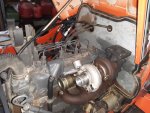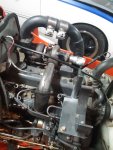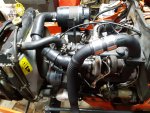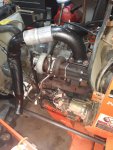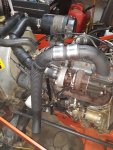Ok, before we start cutting and fitting pipe, there are several things to consider when fabricating an exhaust pipe, specifically regarding steel selection. The two most likely types for a project like this will be stainless steel or mild steel. The choice and application of these two materials can mean the difference between a solid, reliable assembly, versus one that may be difficult to weld and potentially fail down the road.
The main difference is the metal used to form the steel alloy. Stainless steel is alloyed using chromium, whereas mild steel is alloyed using carbon. The two different alloys produce very different results in corrosion resistance, malleability and ease of fabrication, not to mention cost. It is this key difference that separates the two different kinds of steel. Let's take a look at the basic differences between these two alloyed metals as it relates to this project:
(Credit: Thyssen Krupp.
https://www.thyssenkrupp-materials.co.uk/the-difference-between-stainless-steel-and-mild-steel.html).
Stainless Steel:
* Because stainless steel is alloyed with chromium, this metal has a much higher corrosion resistance than mild steel. The chrome in the stainless reacts with the oxygen in the air producing a natural ‘chromium oxide’ protective skin on the surface of the metal which means that as long as this layer is undamaged, the metal is naturally corrosion resistant. Different stainless steel grades contain varied elements to make them more suitable for different environments.
* As chrome is a hard alloy, stainless steels are much more impact resistant compared to mild steel and (although relatively easy to fabricate) are not as easy to fabricate as mild steel.
* Although stainless offers far superior life span and corrosion resistance over its mild counterpart, the various alloying elements (particularly chromium) make it more expensive. Coupled with the additional work required to fabricate, stainless steel is the more expensive option, however, the benefits are an aesthetic metal with superb corrosion resistance and low maintenance.
Mild Steel:
* Because mild steel is alloyed with carbon, it does not have the protective chromium oxide layer of stainless steel, and therefore reacts with moisture in the air to produce an iron oxide layer, or ‘rust’. Mild steel therefore requires further processing such as galvanization or painting in order to give it a protective surface.
* Mild steel is much more malleable compared to stainless and therefore used more extensively in general fabrication.
* Compared to stainless steel, the general cost of mild steel is less for a given quantity depending on the type used.
Whew! Ok, enough with the science class on metals. It may appear as if I am making a case for one type over the other. That is not the case. Each has their pros and cons, obviously, but there is one critical point left to make: Expansion.
As verbose as the above discussion was, this one is short. DON'T MIX THEM. Because of the alloys used to make the two types of steel, they have different coefficients of expansion. This is another deep rabbit hole that you can dive into for greater understanding, but basically, when heated, the two types will expand and contract differently with temperature.
Why is this so important? Two reasons:
First, when fabricating, if you are trying to weld stainless and mild steel together, it can lead to weaker welds or even cracking during the welding process. This can be mitigated with different welding techniques and materials, however, it takes a very experienced welder with the time, knowledge, and equipment to do it.
Second, because of the extreme heat cycling during operation of the tractor, the two different expansion rates of the metals will slowly start cracking the welds between the two, leading to exhaust leaks and a weakened assembly. If this were a room temperature application, you could most likely get away with it if the metals were not under high thermal or physical stress.
There is one more important consideration to make regarding steel type, and that is thermal conductivity. Stainless steel is approximately 3x less thermally conductive than mild steel. Why is this important? When routing the exhaust pipe through tight areas and past plastic or rubber parts, stainless steel will radiate much less heat than mild steel, have less negative affect on nearby parts, and remove more heat from the engine compartment than mild steel.
When looking at the big picture, these considerations will probably have more impact on the overall outcome than almost any other factors in the project. Chose one type of metal and keep the exhaust pipe homogeneous from the turbocharger outlet flange to the tailpipe, route it carefully to maximize distance to delicate materials, and use heat resistive tape or sheets if testing reveals hotspots.
Huh. I thought I was going to start into the exhaust pipe fabrication process today, but decided it was more important to prep any potential builders on the whys and why-nots of steel selection and application.
It took most the afternoon to research and write up this post. I'm pooped! I promise, next post we start fabricating! Cheers until then. . .
Solo




